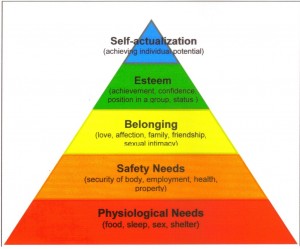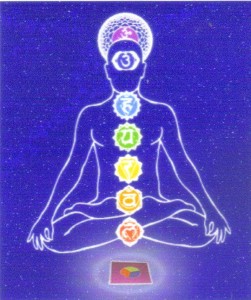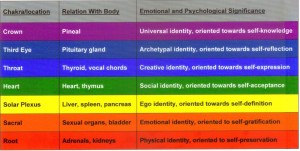Reading through some of the ancient Vedic texts, I was amazed to notice some uncanny similarities between Maslow’s famous hierarchy of needs and the text’s description of the sequence of psychophysical energy centers in our body. Even though the two theories are drawn from very different perspectives, and during substantially different time periods, it was their curious similarities and differences as well as the resultant implications for personal growth that got me energized to write this piece.
You are probably quite familiar with Abraham Maslow’s work – a theory in psychology, written in a paper published in 1943, which set out five fundamental human needs and their hierarchical nature. Maslow studied what he called exemplary people such as Albert Einstein, Eleanor Roosevelt and Frederick Douglass, along with the healthiest one percent of his college student population, to postulate this theory. As you will notice from the pyramid below, the five needs are physiological needs, safety needs, belonging needs, esteem needs and self-actualization needs. A key aspect of the model is the hierarchical nature of these needs. The lower the needs in the hierarchy, the more fundamental they are and the more a person will tend to abandon the higher needs in order to pay attention to sufficiently meeting the lower needs. For example, when we are ill, we care little for what others think about us – all we want is to get better. The first four layers of the pyramid are what Maslow called “deficiency needs”; if they are not met, the body gives no indication of it physically, but the individual feels anxious and tense. Maslow believed that while the deficiency needs may be seen as “basic”, and can be met and neutralized (i.e. they stop being motivators in one’s life), self-actualization is a “being” or “growth” need and hence can be an enduring motivation and a driver for long-term behavior.
Let’s now briefly examine the concept of the psychophysical energy centers in our body. First mentioned in Vedas, the ancient Indian texts of knowledge written around 7th Century BC, varying versions of this idea have also been found and are popular in the Chinese, Tibetan, and Japanese traditions. Seven in number, these centers called chakras (meaning wheels), signify the basic energy centers in the body. Each of these centers correlates to major nerve ganglia branching forth from the spinal column and provides the vital energy for our existence. Theories on chakras fit within systems that link the human body and mind into a single unit, described as psycho-physical, or sometimes called the body-mind. Besides the body functions and the developmental stages of life, they also correlate well with the levels of consciousness of an individual. Reference the picture and the table below, you will note that each of these chakras, denoted by seven different colors that comprise the white light, has a relationship to a specific physical, emotional and psychological aspect of a human being. For example, the Root chakra, located at the bottom of the spine, is responsible for adrenals and kidneys, and relates to physical survival needs. The Sacral chakra is responsible for sexual organs, bladder and prostrate, and related to needs of sexuality and other emotional gratification. And so on and so forth.
Similarities
As you read through the above description, you will recognize some amazing similarities between Maslow’s western psychology and this Eastern philosophy. In a way, the chakras represent the energy centers that govern the hierarchy of needs – Root chakra relating to survival and safety, Sacral chakra relating to love and belonging needs, and Solar Plexus chakra to esteem, power and position; the first three chakras thus representing Maslow’s four deficiency needs. Similarly, Maslow’s self-actualization need kind of correlates to the last four chakras taken collectively, starting from Heart chakra (self-acceptance, balanced perspective, compassion) to Throat (self-expression, deeper connection with others), Third Eye (self-reflection, awareness, intuition) and Crown chakra (self-knowledge, higher consciousness). Interestingly, Maslow did broadly describe certain aspects that he believed to comprise the self-actualization needs, which have subsequently been recognized to be independently important. They have lately been updated as a collection of the following needs – cognitive needs (knowledge, meaning), aesthetic needs (appreciation and search for beauty and balance), self-actualization needs (realizing personal potential) and transcendence needs (helping others to achieve self actualization). Examined this way, they make the Maslow’s theory and the Chakra philosophy look an even greater fit.
Differences and Implications
Having said that, there are significant differences between the two and that has deep implications for the journey of personal growth. I find the chakras philosophy far more comprehensive and powerful in its scope. First, it better captures the relationship between the emotional and psychological facets of an individual and the various body organs. Second, while it has an implicit hierarchy among the different chakras, the philosophy does not preclude someone being more advanced on a higher chakra before being making sufficient progress on the lower chakra – for example, someone could be hugely driven by power (3rd chakra) despite feeling substantially insecure (1st chakra). Finally, the chakra philosophy has a very detailed methodology to heal and bring the various chakras in balance and harmony. While Maslow’s theory outlines the state of a person’s psychological motivation, it inherently assumes that the person is at that stage primarily by nature, or childhood experiences, or the last satisfied psychological need. As against that, the Chakras philosophy lays much greater emphasis and provides guidance on undertaking a path of self-awareness and self-responsibility, akin to willfully following the journey of personal mastery towards greater consciousness.
As we become more familiar with the chakras, it is easy to see how a large part of our society is stuck in the first 3 chakras – food, survival, sex, power and position. However, the philosophy details a method of empowering the other four chakras towards the journey of self-discovery and actualization. As we begin to become more familiar with our true nature and learn to connect with others based on who they essentially are (not biased by age, color, personality, position), we empower our Heart and Throat chakras. As an individual reaches sufficient spiritual awareness to see the larger picture of the universe and not feel attached to any one perspective, they gain greater intuitive ability to clearly see the laws of universe at play; strengthening their Third Eye chakra. Lastly, as the rare few individuals who reach the state of an awakened Crown chakra, they become one with the universe and, devoid of any sense of individuality, reach enlightenment. Several suggested approaches, including yoga, meditation and healing techniques like reiki, provide us ways for healing the chakras and empowering them towards a truly meaningful journey of personal growth.
Related Search Terms:
maslow hierarchy /maslow need hierarchy theory /maslow need hierarchy














 To Create a New Reality, Start with Your Beliefs…
To Create a New Reality, Start with Your Beliefs… The Cycle of Karma…and How Come Nice Guys Don’t Always Get The Top Job?
The Cycle of Karma…and How Come Nice Guys Don’t Always Get The Top Job? Stop Judging, Start Loving!
Stop Judging, Start Loving!
The connect between what is part of our heritage, and the relatively more recent findings is fascinating.
Love the comparison and connection between Maslow and Eastern thought. Well done.
Thanks for the article , very good comparison
Brilliant finding!
Questa Piramide è disegnata al contrario rispetto a quest’altra: https://www.facebook.com/photo.php?fbid=1939100043081478&set=gm.1524162764329703&type=3&theater&ifg=1